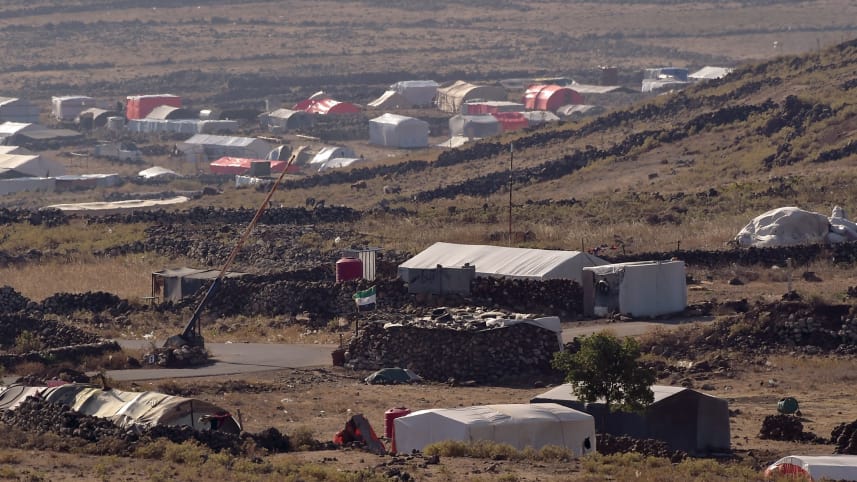Once Enemies, Now Refugees: The New Reality Facing Soldiers on the Israeli-Syrian Border
هآررتس: الأعداء الآن لاجئين: الحقيقة الجديدة التي تواجه جنود اسرائيل على حدودها مع سوريا
Anshel Pfeffer/Moshav Keshet/Haaretz/July 03/18
‘I still remember fighting the Syrian army in Lebanon and eyeballing them here on the Golan. Now there are no soldiers in sight – only Syrian civilians’
MOSHAV KESHET – The Israel Defense Forces maintains dozens of fortified positions and observation posts the length of the Golan border with Syria.
On Sunday, however, as thousands of Syrian refugees streamed toward the border, escaping the relentless bombardment of rebel-held Daraa, the IDF reinforced its units on the Golan Heights, tanks and infantry sections overlooking the new refugee camps that had sprung up just a few hundred meters from the border fence on the southern Golan.
Every few seconds on Monday, dull explosions of artillery fire could clearly be heard from the Israeli side and mushrooms of smoke arose from the low ridge across the border in Syria.
But it was clear that the Assad regime’s gunners were making sure, as they shelled the refugees’ escape route, not to risk hitting too near the Israeli positions. All the shells seemed to be landing at least 3 kilometers (1.8 miles) from the border, and the soldiers in the observation posts confirmed that none had come close.
And still a steady trickle of refugees continued to arrive. Some on foot, others on motorbikes, and the occasional car. The United Nations has assessed that over 250,000 civilians have been displaced in recent days by the concerted push by the Assad regime and its Russian allies on the Daraa region.’
The great majority of these have fled either eastward or toward the nearby Jordanian border. Some, though, have made the longer and more dangerous journey to the Golan.
The incentive is that once they arrive near the Israeli border, they are relatively safe. Lt. Col. E., the commander of the IDF’s humanitarian assistance operation on the Golan, said Israel had not officially created a safe buffer zone, but that “during the last few years, these villages [on the border] were attacked less often than other places in Syria.”
The villagers do indeed seem accustomed to life with bombardments on the near horizon. As refugees milled around the two camps of orange and white tents transferred across the border by the IDF last Thursday night, local shepherds continued grazing their sheep, all the way up to the fence.
“We haven’t seen any refugees try and get close to the fence,” said an armored corps officer, sitting with his tank crew at one of the observation posts near Moshav Keshet. “I don’t believe they will try. There are minefields on the border and they won’t take any risks. At least, I hope they won’t,” he added.
The soldiers’ orders are to prevent any unauthorized breaches of the border – if necessary by firing warning shots on the ground near the refugees.
Infantry reinforcements are on alert nearby for crowd control, should the need arise. Unlike the Gaza border, though, no one here expects to be using deadly force to prevent anyone from crossing.
“The Syrians have been educated their entire lives to see Israel as their enemy. I think that for many of them that remains a psychological barrier,” says an officer of the regional Bashan Division.
No risks are being taken, but the operational assessment is that the refugees will not try to cross the border and instead will make do with taking shelter near the fence, living for the time being off the food supplied by the IDF, donated in part by Israeli, American and Arab NGOs.
Another reason for making the journey to the Israeli border is the guarantee of medical treatment.
Israel has allowed some 4,000 wounded Syrians to pass through the border over the last five years, where they have received medical aid. And they continue to arrive at the small locked gateways at the border. “Last night, a young man who had lost a leg was brought here,” recounts a tank crew member. “The UN observers let him through and an IDF ambulance took him to hospital. We were on alert to make sure it wasn’t an ambush, but it all ended very quietly.”
The Assad regime, with the crucial help of its Russian and Iranian allies, has now retaken much of the lost territory. Yet despite overwhelming firepower, much of the Daraa and Golan regions still remain outside of its grasp.
As the regime’s forces have become bogged down once again, the Russians and Jordanians are trying to broker an agreement with Daraa’s rebels. But one of the last strongholds of the civil war that broke out over seven years ago is reluctant to surrender. Like millions of refugees of this war, those who have just arrived on Israel and Jordan’s borders have no idea when, if ever, they will be allowed to return home.
For the last 50 years, the entire topography of the border has been built to accommodate two large conventional armies, warily watching each other. Every few hundred meters, the landscape is dotted with military communications masts, communications trenches, bunkers and tank positions, built from dark-brown earth and black basalt rocks.
For decades, the Israeli and Syrian armies practiced bringing brigades of tanks or armored personnel carriers to the frontline. But for the past seven years, since the civil war broke out, there has been just one army on the border.
The Syrian military has dwindled and its remnants are now split into regime forces and rebel groups, busy fighting each other and killing civilians. For now at least, instead of facing an enemy army, Israel is dealing with the human detritus of the war.
“It’s a strange sensation,” says a senior officer who arrived from General Staff headquarters in Tel Aviv to inspect the preparations on the border.
“I still remember fighting the Syrian army in Lebanon and eyeballing them here on the Golan,” the officer continued. “Now there are no soldiers in sight and our main operation here is with Syrian civilians.”





















